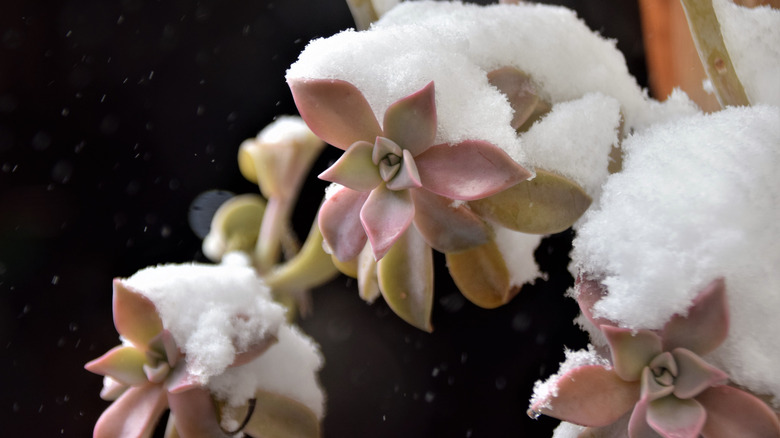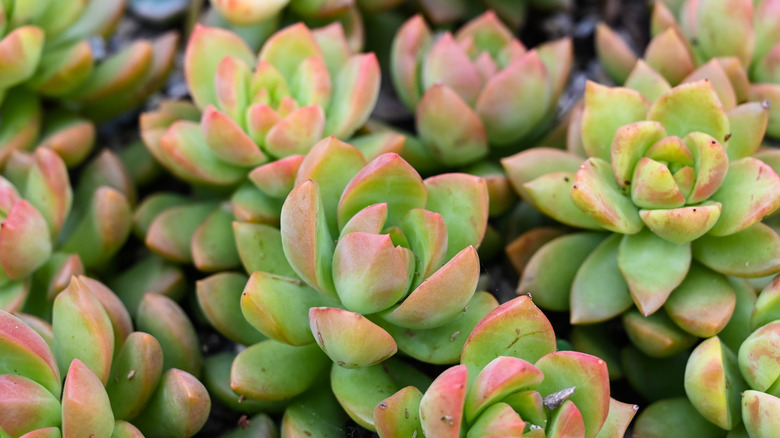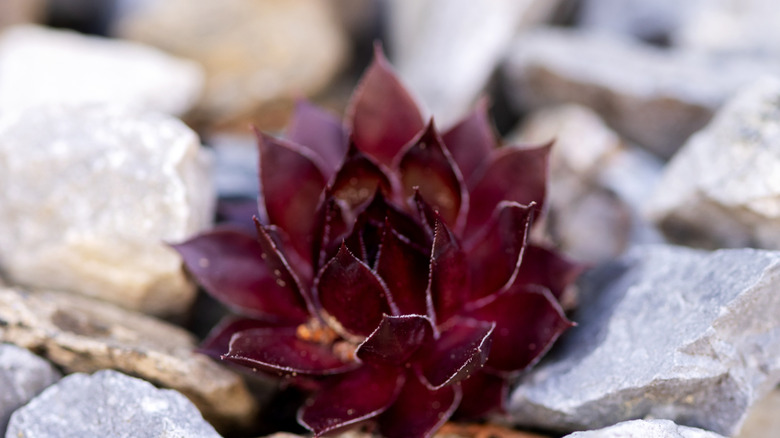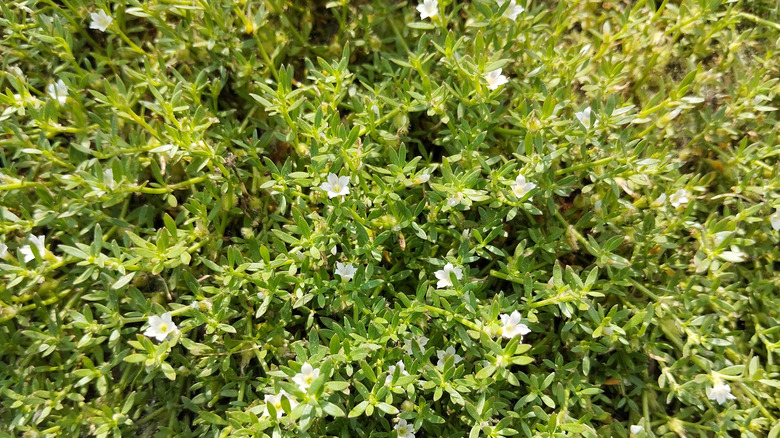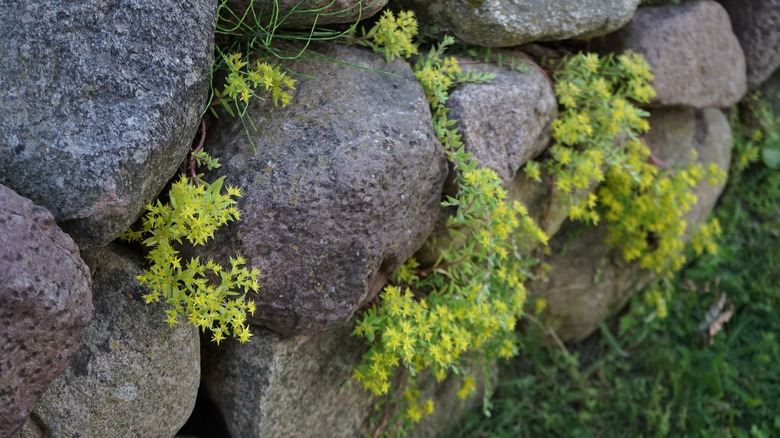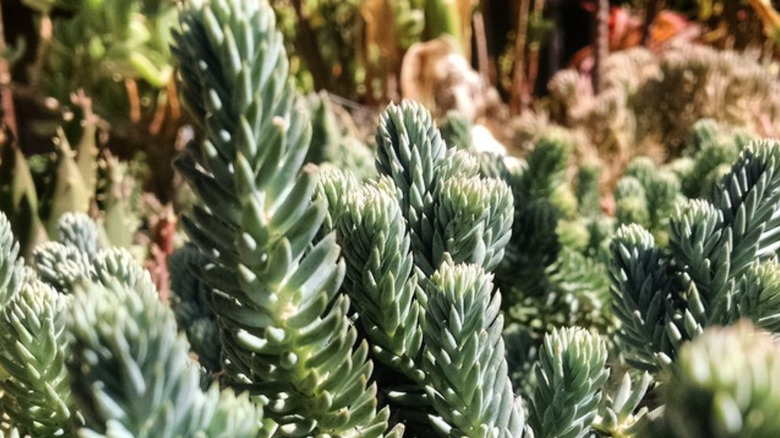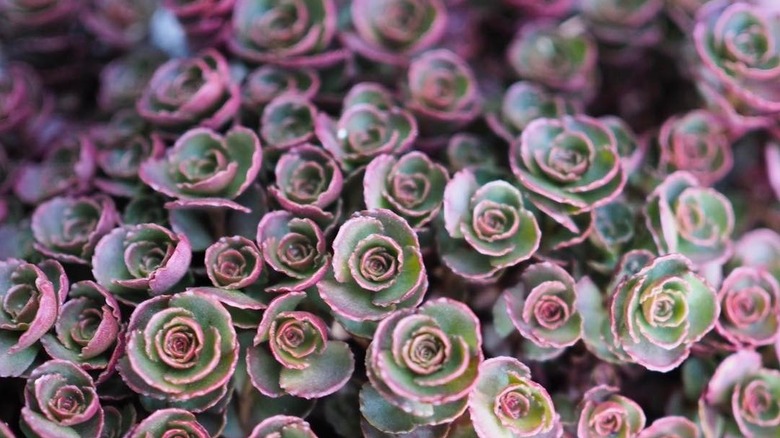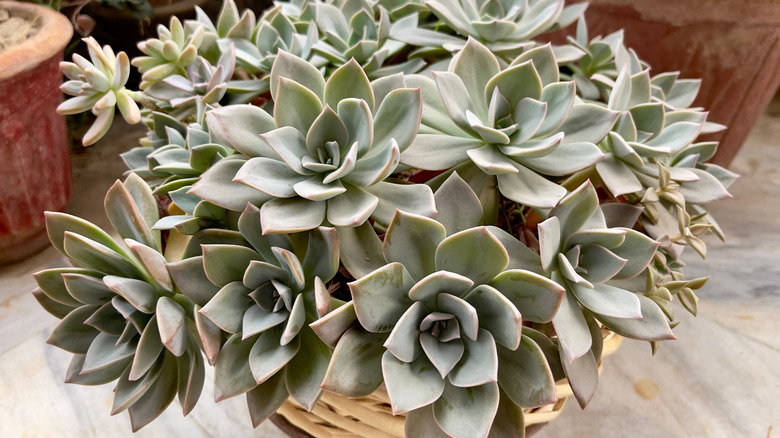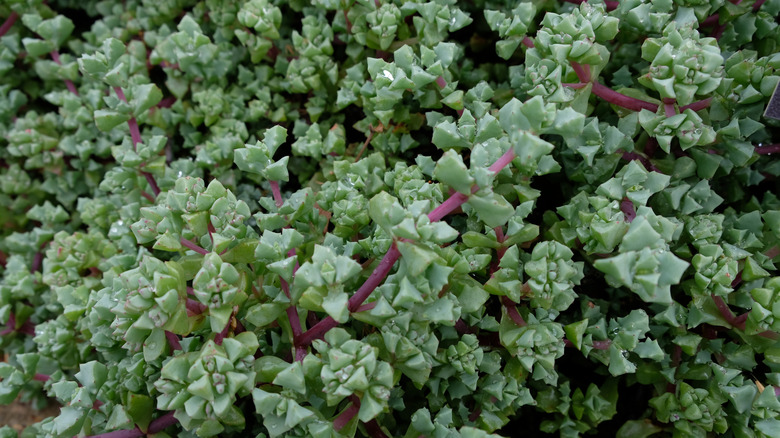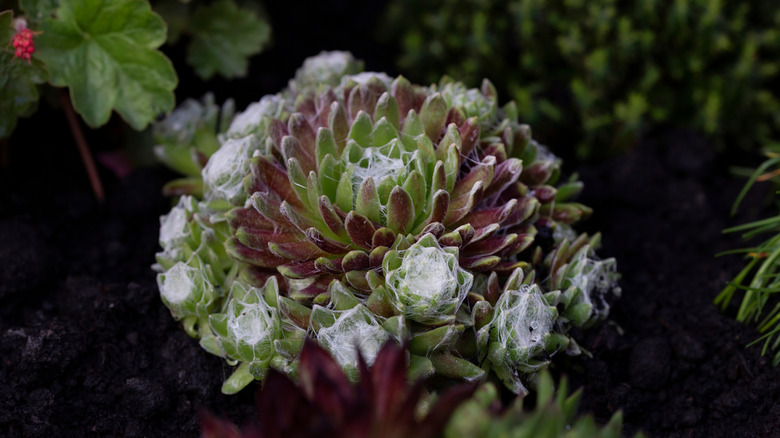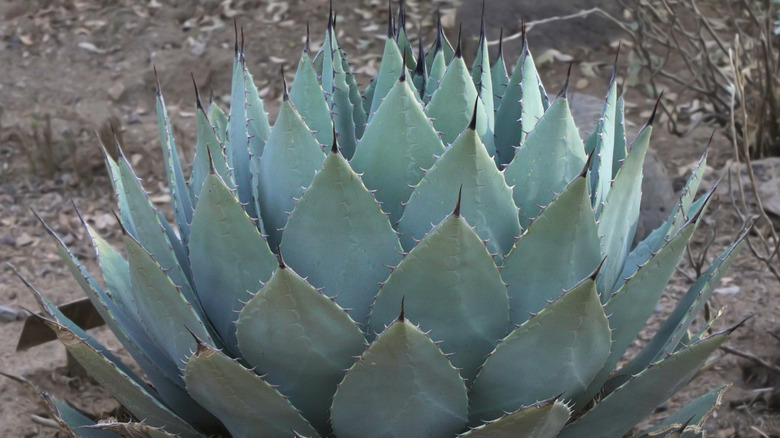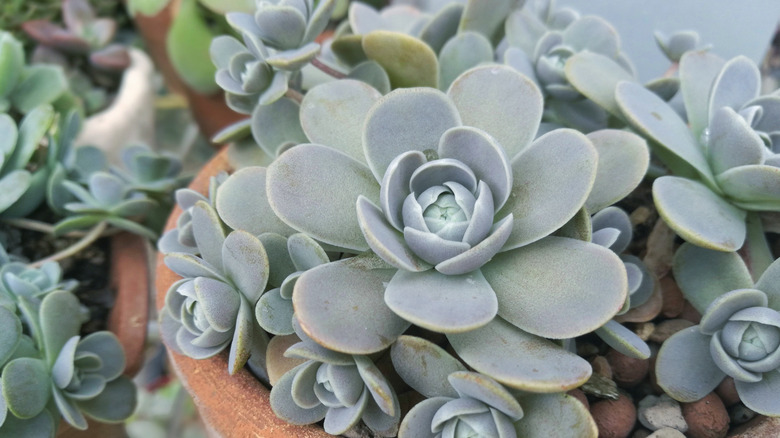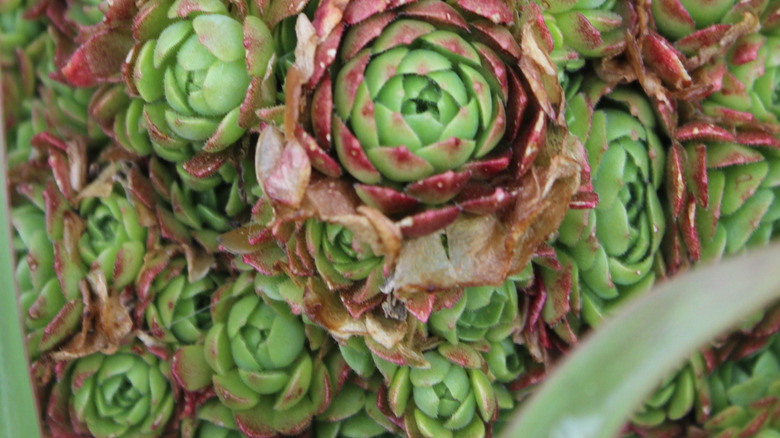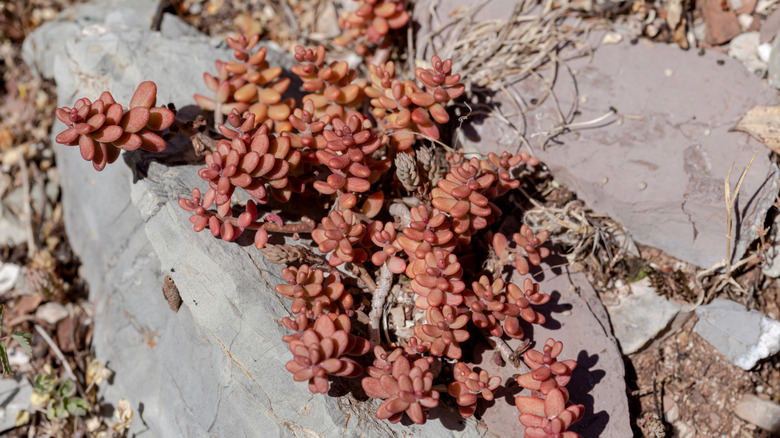17 Cold-Hardy Succulents You Can Plant Just In Time For Winter
We may receive a commission on purchases made from links.
Many amateur and experienced plant parents find themselves drawn to succulents because of their reputation for being easy to care for. Many of them can also be propagated, thus allowing for even more plants later on. Succulents have even been reported to relieve stress and provide a feeling of success when grown well. However, these famously hardy plants can sometimes be difficult to maintain in certain environments, especially if the soil, temperature, or water level isn't right for them. This can often lead to frustration for those who purchase or propagate succulents thinking that they're a good fit for their local climate.
To avoid this frustration — and the sadness of losing yet another plant this winter — look into which types of succulent are more likely to thrive throughout the colder months, from bright red varieties, such as the Sempervivum 'Red Beauty,' to the fascinating Aloe 'Blue Elf,' with its spiky, blue-green leaves and red blooms. These cold-resistant succulents are a great way to bring life, color, and intrigue into your garden during the coldest time of year. The majority of these cold-hardy plants prefer well-drained soil, and some are prone to spreading quickly when the conditions are right — they should be kept in check to protect your surrounding plants. If you're looking into succulents that thrive in outdoor environments, and how to care for them, this list can help you find the perfect ones for you and your winter yard.
Sedum 'Golden Glow'
Believed to be a Sedum family hybrid, this charming succulent is a great choice if you ted to mourn the beautiful colors of autumn as winter sets in. Sedum adolphi 'Golden Glow' has small, green leaves edged with a little orange that can actually turn to red in strong sunshine. Extremely cold-hardy, this little plant is reported as withstanding temperatures down to -40 degrees Fahrenheit in hardiness zones 3 to 9. It can also grow quickly in well-draining soil and is therefore a good option for propagation to help fill out your garden this winter.
Sempervivum 'Red Lion'
If you'd like an even more impressive spot of red in your garden, opt for the Sempervivum 'Red Lion.' This hardy succulent can be planted outdoors in temperatures as low as -30 degrees Fahrenheit in hardiness zones 4 to 6. It has broad leaves with an eye-catching red color that can cover the entire leaves, alongside some spots of green or yellow. It grows well in partial or full sun and can be boosted with fertilizer at the beginning of spring or summer to help it thrive in the subsequent growing season.
Cylindropuntia whipplei 'Snow Leopard'
Perhaps you're looking for something a little unusual that lasts through winter? The Cylindropuntia whipplei 'Snow Leopard' certainly checks that box. A drought-tolerant cultivar that thrives in hardiness zone 5 and can handle -20 degrees Fahrenheit, the 'Snow Leopard' is classified as both a cactus and a succulent, meaning it is covered in stunning, icy-white spikes from top to bottom. Not only does this plant add some visual appeal to your garden, it can also be used to keep intruders off your property.
Sedum spurium 'Voodoo'
Want something a little less prickly but that still has plenty of interesting shape? The Sedum spurium 'Voodoo' features attractive, scalloped leaves in a fascinating deep red and green combination. This succulent grows happily in hardiness zones 3 to 8 and works as an effective groundcover in dry or moderately watered soil. Able to withstand an impressive -40 degrees Fahrenheit, the 'Voodoo' is a great option for adding drama to the garden in winter. Some of its leaves may fall off during its dormant period, but they should return with the coming of spring.
White stonecrop
Sometimes you need something to look forward to in order to get through the winter. White stonecrop (Sedum album) is perfect because its beautiful, delicate white flowers bloom throughout the summer, bringing winter-white to your garden from June to August. In the meantime, its red-brown winter foliage adds charm to your rock gardens and borders. It can stand cold temperatures of 15 degrees Fahrenheit in hardiness zones 3 to 8. When summer does come around again, its leaves should return to a pleasant, light-green shade. Keep it in check so it doesn't spread too much.
Gold Moss Sedum
The Sedum sarmentosum, also called 'Gold Moss' or 'Stringy Stonecrop,' thrives in hardiness zones 3 to 8 and can survive temperatures as low as -40 degrees Fahrenheit. It does well in borders, on walls, and in containers with well-draining soil, such as the Miracle-Gro cactus, palm, and citrus potting mix. This succulent is known for trailing green stems, creating an attractive waterfall effect over its surroundings. Keep in mind that stringy stonecrop can grow very fast and may take over smaller plants, so it's best planted where it can be kept in check.
Sedum 'Turquoise Tails'
Sedum 'Turquoise Tails' is a low maintenance succulent option that offers a mellow blue-green color, which is great for adding a seasonally appropriate hue to your winter garden. Tolerant of hardiness zones 5 to 10 and temperatures down to -20 degrees Fahrenheit, it prefers full sun and can grow up to ½ foot tall, providing some height to your beds and rock gardens. It is also helpful to local pollinators due to its tall yellow flowers which appear in summer. To maintain good drainage, try making an easy DIY soil mix that helps plants thrive without waterlogging.
Aloe 'Blue Elf'
If you like the vertical shape and blue-green leaves of the 'Turquoise Tails,' you may also be interested in Aloe 'Blue Elf'. This fascinating, spiky plant is relatively cold-tolerant — able to handle 20 degrees Fahrenheit — and can provide a tall, visually appealing addition to gardens in hardiness regions 9 to 11. In addition, you can look forward to the 'Blue Elf' bursting with even more color in the summer, when its bright orange blooms tend to appear.
Sedum spurium 'Dragon's Blood'
This plant doesn't just have a cool name. The Sedum spurium 'Dragon's Blood' is an eye-catching succulent that boasts red leaves and pink spring-summer flowers. It can add great color to your winter garden as well as your summer one. It can handle temperatures as low as 15 degrees Fahrenheit in hardiness zones 3 to 8. Older leaves tend to fall off in winter, but new growth stays on the plant during the cold months, turning an even deeper shade of red for a rich, elegant feel.
Graptopetalum paraguayense
Generally happy in hardiness zones 8 to 11, this attractive succulent features large flower-like clusters of leaves that are tough enough to withstand a low temperature of 5 degrees Fahrenheit. Amazingly, the leaves of this blue-grey plant have even been known to come back to life after freezing in the winter. In addition, the Graptopetalum paraguayense — also known as 'Ghost Plant' — can grow up to 1 foot tall, so it's great for use as a statement piece. Keep in a bright, sunny location with well-draining soil to help its large, clumped leaves thrive throughout winter.
Oscularia deltoides
Another great statement plant, the Oscularia deltoides comes with odd, geometric leaves that look like something out of a cubist painting. Suited for hardiness regions 8 to 11, this plant is known for being relatively cold-hardy with an ability to survive temperatures down to 15 degrees Fahrenheit. Native to the sandstone regions of South Africa, it appreciates loose soil and light, regular watering. To receive its full colorful effect this winter, plant it where you can also glimpse the bright pink stems, which beautifully offset this plant's light blue-green foliage.
Sempervivum 'Red Beauty'
If you like the icy blue color of the Oscularia deltoides and the Aloe 'Blue Elf' but want a touch more color, then the Sempervivum 'Red Beauty' might be perfect for you. With large, pale rosettes tipped with bright pink spikes, this Sempervivum grows well in hardiness zones 4 to 9 and can tolerate -20 degrees Fahrenheit. Sempervivum are often described as a hen and chicks plant because of the large mother rosette that branches off into smaller clusters (known as "chicks"). This means they are perfect for use as groundcover or for filling out borders.
Sempervivum Arachnoideum
Another "hen and chicks" Sempervivum, this variety is sure to get some interested comments from passersby. The clue is in the name, Sempervivum Arachnoideum; this unique succulent produces a webby material over its leaves that helps catch water, create shade, and insulate the plant from extreme temperatures. This may be one of the reasons this succulent is relatively cold-hardy, surviving in hardiness zones 5 to 8 and temperatures down to 14 degrees Fahrenheit. Let this plant thrive by offering it full sun and well-draining soil to get a fascinating, web-like feature for your garden.
Parry's Agave
This type of agave, known by the scientific name Agave parryi, is impressively hardy in both hot and cold temperatures with an ability to withstand lows around 15 to 20 degrees Fahrenheit. However, this plant is native to dry climates, so it's more tolerant to dry winters than ones that see a lot of precipitation or humidity. Look out for agave weevils, whose larvae can tunnel into the plant and damage its health. Additionally, make sure to plant it in an area with good drainage to avoid the possibility of root rot.
Orostachys boehmeri
Part of the larger Orostachys family, the Orostachys boehmeri — sometimes called 'Duncecap' due to its cone-like shape — is a sweet, light green succulent with rounded leaves and delicate, spindly runners. Native to Asia, it thrives in hardiness zones 6 to 10 and is said to survive in temperatures even lower than -30 degrees Fahrenheit. To help your 'Duncecap' survive and thrive in winter, reduce watering to prevent waterlogged soil. Don't worry if it doesn't grow as quickly in the colder months; it tends to be less active in extreme temperatures.
Rosularia platyphylla
For a unique, bouquet-shaped plant that is hardy in temperatures down to -20 degrees Fahrenheit, look no further than the Rosularia platyphylla. This fascinating succulent grows in tight balls with rosettes that feature an ombre effect from green to dark red. Plant the Rosularia platyphylla in full sun in hardiness zones 5 to 10 to enjoy the year-round visual interest of this plant. Make sure to only water the roots because overly wet leaves can end up rotting. If possible, place it in a rocky location similar to its native Middle Eastern environment.
Sedum stahlii
Finally, for a stunning succulent that brings bright color to your yard in the winter months and beyond, consider the Sedum stahlii, also known as 'Mexican Sedum.' This sweet plant grows on stems that reach around 8 inches in height and has green, auburn, or brown foliage (as well as summer-blooming yellow flowers). It can handle low temperatures of 14 degrees Fahrenheit and prefers hardiness zones 8 to 10. In addition, this plant can be used to spill out of containers and borders that get full sun for an eye-catching cascade effect.
